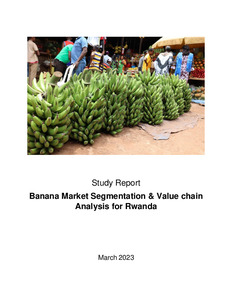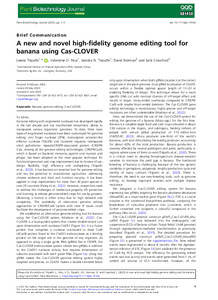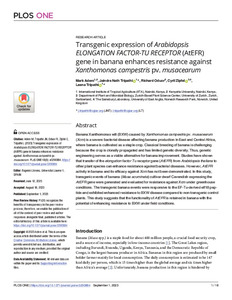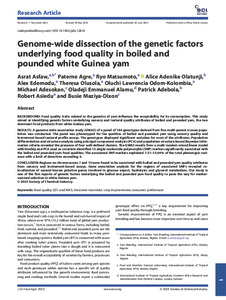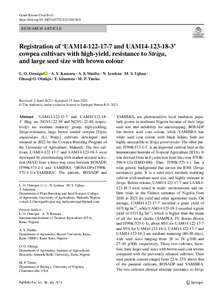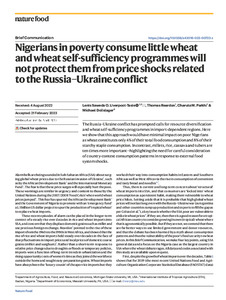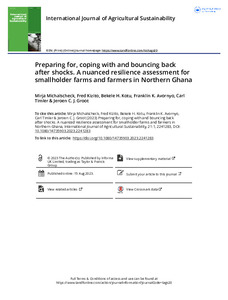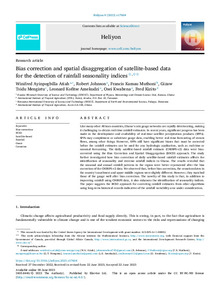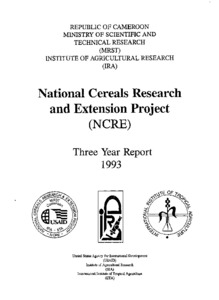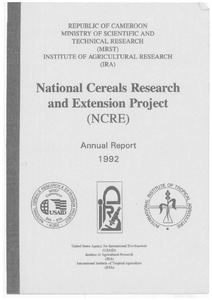Welcome to the International Institute of Tropical Agriculture Research Repository
IITA Bibliography System: Recent submissions
Now showing items 401-420 of 8094
-
Banana market segmentation & value chain analysis for Rwanda: study report
(International Institute of Tropical Agriculture; Rwanda Agriculture and Animal Resources Development Board, 2023-03)A study was conducted in Rwanda to identify and characterize different banana market segments, with a focus on cooking and dessert bananas. The goal was to generate production and market-related information to inform the development of banana target product profiles (TPPs) for Rwanda, which can support crop development programs and other actors in meeting the needs of different end-users such as farmers, processors, and consumers. The study employed a mixed-methods approach consisting of qualitative ... -
Influence of altitude as a proxy for temperature on key Musa pests and diseases in watershed areas of Burundi and Rwanda
(2023-03)Pests and diseases are key biotic constraints limiting banana production among smallholder farmers in Eastern and Central Africa. Climate changemay favour pest and disease development and further exacerbate the vulnerability of smallholder farming systems to biotic constraints. Information on effects of climate change on pests and pathogens of banana is required by policy makers and researchers in designing control strategies and adaptation plans. Since altitude is inversely related to temperature, ... -
Transgenic expression of Arabidopsis ELONGATION FACTOR-TU RECEPTOR (AtEFR) gene in banana enhances resistance againstXanthomonas campestris pv. musacearum
(2023-09-01)Banana Xanthomonas wilt (BXW) caused by Xanthomonas campestris pv. musacearum (Xcm) is a severe bacterial disease devastating banana production in East and Central Africa, where banana is cultivated as a staple crop. Classical breeding of banana is challenging because the crop is clonally propagated and has limited genetic diversity. Thus, genetic engineering serves as a viable alternative for banana improvement. Several studies have shown that interfamily transfer of the elongation factor Tu ... -
Advances in somatic embryogenesis of banana
(2023-07-01)The cultivation of bananas and plantains (Musa spp.) holds significant global economic importance, but faces numerous challenges, which may include diverse abiotic and biotic factors such as drought and various diseases caused by fungi, viruses, and bacteria. The genetic and asexual nature of cultivated banana cultivars makes them unattractive for improvement via traditional breeding. To overcome these constraints, modern biotechnological approaches like genetic modification and genome editing ... -
Genome-wide dissection of the genetic factors underlying food quality in boiled and pounded white Guinea yam
(2023-06-30)BACKGROUND Food quality traits related to the genetics of yam influence the acceptability for its consumption. This study aimed at identifying genetic factors underlying sensory and textural quality attributes of boiled and pounded yam, the two dominant food products from white Guinea yam. RESULTS A genome-wide association study (GWAS) of a panel of 184 genotypes derived from five multi-parent crosses population was conducted. The panel was phenotyped for the qualities of boiled and pounded yam ... -
Registration of ‘UAM14‑122‑17‑7 and UAM14‑123‑18‑3’ cowpea cultivars with high‑yield, resistance to Striga, and large seed size with brown colour
(2023-07-06)‘UAM14-122-17-7 and UAM14-123-18-3’ (Reg. no. NGVU-22-39 and NGVU-22-40, respectively) are medium maturity group, high-yielding, Striga-resistance, large brown seeded cowpea [Vigna unguiculata (L) Walp.] cultivars developed and released in 2022 by the Cowpea Breeding Program of the University of Agriculture, Makurdi. The two cultivars UAM14-122-17-7 and UAM14-123-18-3 were developed by crossbreeding with marker-assisted selection (MAS) from a three-way cross between BOSADP, IT99K-573-1-1 and YAMISRA ... -
Nigerians in poverty consume little wheat and wheat self-sufficiency programmes will not protect them from price shocks related to the Russia–Ukraine conflict
(2023-04-06)The Russia–Ukraine conflict has prompted calls for resource diversification and wheat self-sufficiency programmes in import-dependent regions. Here we show that this approach would have minimal impact on poor Nigerians as wheat constitutes only 4% of their total food consumption and 8% of their starchy staple consumption. In contrast, millets, rice, cassava and tubers are ten times more important—highlighting the need for careful consideration of country-context consumption patterns in response ... -
Convolutional neural network allows amylose content prediction in yam (Dioscorea alata L.) flour using near infrared spectroscopy
(2023-07-03)Background: Yam (Dioscorea alata L.) is the staple food of many populations in the intertropical zone where it is grown. The lack of phenotyping methods for tuber quality hinders the adoption of new genotypes from the breeding programs. Recently, near infrared spectroscopy (NIRS) has been used as a reliable tool to characterize the chemical composition of the yam tuber. However, it failed to predict the amylose content, although this trait is strongly involved in the quality of the product. Results: ... -
Assessment of the impact of crop management strategies on the yield of early-maturing maize varieties in the drylands of Niger Republic: Application of the DSSAT-CERES-Maize model
(2023-07-04)Maize is increasingly becoming important in Niger for use as food and feed. Production is however, faced with several abiotic and biotic constraints. Researchers have developed early-maturing maize varieties that are tolerant to drought, the parasitic weed Striga hermonthica and diseases that fit into the short growing production environment. The evaluation and deployment of these varieties would, however, involve costly and time-consuming field trials across the maize production zones of the ... -
Preparing for, coping with and bouncing back after shocks. A nuanced resilience assessment for smallholder farms and farmers in Northern Ghana
(2023)Smallholder farmers in Northern Ghana regularly face shocks, challenging the sustainability of their farms and livelihoods. Different farm households and household members may be differently affected and respond with different coping strategies. We combined whole-farm modelling and farmer consultations to investigate the vulnerability, buffer and adaptive capacity of three farm types in Northern Ghana towards severe climate, economic and social shocks. We further assessed intrahousehold differences ... -
Group Annual Reports and Financial Statements for the year ended 31 December 2022
(IInternational Institute of Tropical Agriculture, 2023-05-15) -
Bias correction and spatial disaggregation of satellite-based data for the detection of rainfall seasonality indices
(2023-06-22)Like many other African countries, Ghana’s rain gauge networks are rapidly deteriorating, making it challenging to obtain real-time rainfall estimates. In recent years, real-time satellite precipitation products (SPPs) development and accessibility have advanced significantly. SPPs may compliment or substitute gauge data, enabling better real-time forecasting of streamflows among other things. SPPs, on the other hand, contain considerable biases that must be addressed before the rainfall predictions ...

